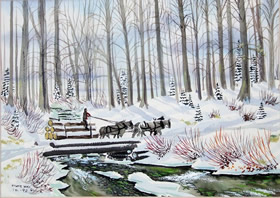Memories of Early-day Horse Transportation
and Logging in Wallowa County, Northeastern Oregon
By Eugene B. Hayes
Horse-pulled sleds
Horse-pulled sleighs were an excellent winter mode of transportation, whether in the log woods or at the barn; hauling hay, wood, posts and poles; hauling feed and groceries from a local market; or for pleasures such as a sleigh ride, or a trip off to a neighbor’s house for a party or a card game and visiting. Throw in some hot chocolate, donuts, and maybe a taffy pull, and it made for some good old-fashioned fun.
In winter, neighbors were generous about giving children a ride to or from school, if they were happening along about the right time.
The driver of the team would need to be bundled up, usually with long johns. Another article of clothing men used was an ear cap. This was made from the top eight inches of Momma’s old silk stocking. This cap would fit any size of a head, keeping the ears flat to the head and warm.
Logging in the early 1900’s
Most people here came from Virginia and West Virginia. They settled in the Promise area north of Wallowa, where there was a lot of old-growth timber. Some of the family names of early settlers were Frank Gregory, Hescock, Henderson, Prince, Gorbett, Collins, Lively, Lyons, Colpitts, Trump, Carper, and Doud. Each family was allotted 160 acres on a homestead. Some families who moved here had several siblings, each with large families.
The whole area was heavily forested, so these early settlers had to cut out trees to put in a house and garden. It was big timber—fir, pine, and tamarack. One fir I saw was 8 feet in diameter. There was a lot of timber in the Promise area during the teens and around Maxville in the1920’s, and lumbering was going big by the early 20’s.
The bigger logging outfits had a number of men doing a variety of jobs:
- 4-6 two-man crews sawed the timber, using a crosscut saw.
- 2 skidding crews did the skidding. A team of horses hauled logs down to the chutes or directly to the landing, where they were decked, then loaded onto sleds, wagons, or even trains (in the Maxville area). Each skidder had a helper, called a swamper. The teams of work horses were owned by the skidders.
- Log haulers. These men were separate contractors. During the teens, draft horses were used with a sleigh or wagon. Sled logging worked well during winters with a lot of snow and cold weather. There was plenty of snow under the sled runners, so they would run smooth and easy. Another method of hauling logs was by using spool carts, 2-wheeled vehicles with no tongue, pulled by 6 horses or mules. Two of these were used together to carry logs. With the 20’s came the Mack truck with its hard rubber tires. Then from around 1928 on, the International (and other
make) log trucks with aired rubber tires were used.
- Saw filers, cooks, and bull cooks completed the workforce. The bull cooks hauled and sawed firewood for the cookstove and hauled water for cooking and dishwashing. My dad, Hugh J. Hayes, Sr., worked as a bull cook at the age of 16 or 17.
The logging camp at Goebel’s place up Bear Creek had a store and 2 barns during the teens and 1920’s. Up Goebel’s Canyon, where the woods crew lived, were a barn, a bunkhouse, and a kitchen/mess hall.
There were several sawmills in the early part of the 1900’s. Tom and Dave Scott operated a sawmill on Smith Mountain in the early teens. The Huber Mill and the Davis Logging Company both ran sawmills on Bear Creek during the 1920’s. The Nibley-Mimnaugh Mill operated in the town of Wallowa. Ashby, who brought in the first Black woodsmen, operated the mill in the 1920’s and 30’s. Later, Bates owned the mill.
For more information on logging in the Maxville, read this article from the Wallowa History Center at http://www.oregongenealogy.com/wallowa/maxville.htm
Copyright, Eugene B. Hayes, 2008. All rights reserved.








